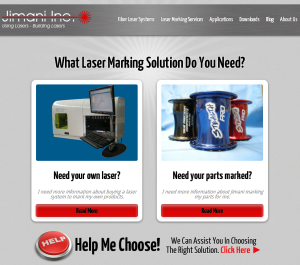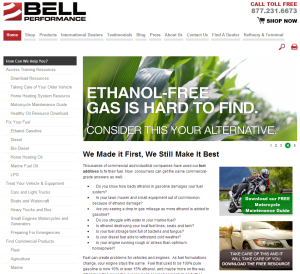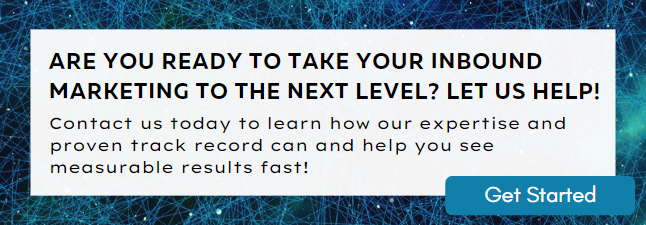Posted by Todd Hockenberry ● Jul 18, 2023
Marketing Capital Equipment? 7 Things Your Website Needs
It is beyond arguing at this point that industrial equipment buyers have changed their behavior based on the Internet. Buyers turn to the internet to look for information about companies and capital equipment before purchasing.
That information-gathering process is crucially important. When buyers find your capital equipment website, the information they find and the impression your website makes can greatly influence your credibility. When someone gives your company a referral, the prospects go first to your website. When you meet someone at a trade show, they will always visit your website for more information.
The buying process can be tilted in your favor from the very first online engagement if your website includes, at the very least, these seven elements.
1. Great Images + Video

If you are building a piece of capital equipment, there is no excuse for poor images. Take high-quality photos of your equipment in action and on the floor of your customer's shops. Show real people using it to solve real problems in real situations.
Videos are also critical for marketing capital equipment. Our clients consistently draw and engage visitors using real videos of the capital equipment being used. Focus on specific solutions and not just feature dumps of your equipment.
If the capital equipment solves a problem for a specific industry, processing a specific material a certain way, for instance, show that to your site visitors.
Trade shows are a few days a year. Videos on your website are 24/7 demos of your technology. Showing is worth a lot of explaining. Plus, younger engineers and project managers are used the seeing everything in a video. If your equipment is not shown in action, your website and your company take a huge credibility hit.
No video means many visitors will bounce until they find a supplier that shows them equipment in action.
It’s a mistake to assume that visitors to your website will understand the connection between a piece of your equipment and their solution. Connect the dots for them with images and videos. Again, the more specific these videos and images are, the better.
2. Brief Statement of Value
Describe what you do, for whom, and why in less than ten words. People either find something compelling on your site in less than 10 seconds, or they bounce on to the next site - your competitor's site.
Make sure any visitors understand unambiguously what you do and why. The worst thing you can do is leave visitors to your website scratching their heads, confused about exactly what you’re offering.
The rest of the home page can feature supporting information. Things like customer testimonials and other independent corroboration are great because they show visitors that you are what you say you are.
This statement of value goes hand in hand with great images; you want visitors to very clearly and easily understand who you are and what you are offering.
Too many capital equipment manufacturer websites start with vague generalities like process-oriented or technical solutions. These terms mean nothing without context.
Talk about the results you deliver with specific numbers.
Material handling automation for CPG companies with X throughput, for example.
3. Compelling Offer
A compelling offer is a thing that moves a visitor towards a conversion. An offer can be a demo, trial, sample, whitepaper, list, survey, or something that appeals to the visitor in terms of the things that they value.
Suppose you deliver a particular capital equipment solution that eliminates manual operation. In that case, an offer that details the benefits of automation versus manually completing the work makes sense from a visitor’s perspective.
The goal with your offers should be to provide something that visitors to your site actually want. Sure, if a visitor is farther into the buying journey, they might want a specs sheet. However, a specs sheet is probably not a compelling offer for someone who is visiting your site for the first time.
Figuring out what your offers should be is often easier once you’ve completed your persona research and development. You should create offers that speak to your personas and help them solve problems.
The compelling offer is a key differentiator between a catalog website and a good Inbound Marketing website. It is the difference between a billboard and a ‘how to’ guide. Catalogs are about you; valuable offers are about them.
But beware. Buyers know the deal with tired old ebooks, for example. If they convert, they get bombarded with emails and sales calls. Make sure your offer is actually compelling and valuable enough for a prospect to risk the onslaught of marketing and sales outreaches.
4. CTAs and Landing Pages

Once you have an offer, a CTA or call to action button attracts the visitor to the offer and gives them a place to start the conversion process. CTA's are attractive graphical buttons that draw visitors' attention and lead them to the landing page.
The conversion takes place on a landing page where the offer is described in more detail regarding the value the visitor can expect. The visitor must fill out a form on the landing page in exchange for the offer. So, the CTA leads the visitor to the landing page for the offer; they fill out a form, and boom, conversion to a lead.
Because the CTA attracts attention and funnels visitors to your offers, it is worth spending some time creating them. If you’re unsure what CTAs will work best, A/B testing can help you find the right style and text for optimal results.
5. Sharing Options
Make it easy for visitors to share valuable offers and interesting content using social share buttons. This assumes that you have varied social media accounts set up and active.
We are constantly surprised by how capital equipment buyers use social media. Give visitors a chance to help you spread the word by having active LinkedIn, Twitter, Facebook, and, most importantly, YouTube share options.
6. Easy Ways to Contact You
Please list your phone number in prominent places. You want to make it easy for visitors to call you. Hiding your contact information or making visitors dig for it is a great way to frustrate and lose those contacts.
We recommend using website-only phone numbers and tracking the calls that are generated from the site. Our customers typically get over half of their website leads from phone calls. Track these, and you can get a clear picture of the performance of your website.
Create and display contact buttons so that people have options regarding how they approach you. Some people will only call, some will never call and only want to communicate via email. Give them options so that they can choose.
Chat. One of the biggest areas of opportunity for capital equipment companies. This one addition to your site will grow leads faster than just about anything else.
Yes, you will get some tire kickers and some dumb questions. But they are well worth it. I promise you that your prospects will use chat if you make it available.
Yes, you need resources to handle chat. If you want a recommendation to a very good third-party chat provider, please contact me.
7. Reasons to dig deeper
If you have a blog, case studies, educational content, how to's, checklists, surveys, technical specifications, drawings, and other valuable content, you can engage visitors in deeper and more thorough conversations.
Blogging is the easiest way to stay engaged with visitors, leads, and customers. You can let people subscribe to updates and use blog content as the jumping-off point of your email campaigns. Either way, you are staying current, showing expertise, and giving them a reason to pay attention to you.
Using blog and email campaigns for early-stage prospects is an effective way to nurture prospects through the buying process. Using these tools to bombard prospects with sales pitches will have a negative effect, hurt your credibility, and annoy them to no end.
Consider next-level content creation like podcasts, YouTube shows, or regular live events. The trends are to create more community-oriented content. Experiment with creating an audience that subscribes to hear what you have to say.
Valuable content means valuable to them, not a stream of sales messages.
Your content should educate and inform visitors about the things they care about - pricing and costs, potential issues and problems with your solution, how you stack up against the competition (both good and bad), options and customization for their particular situation, how you handle the entire buying and support process from commissioning to replacement, and third-party comments, reviews, and opinions.
Be helpful, and prospects will respond.
Topics: Marketing, Manufacturing





